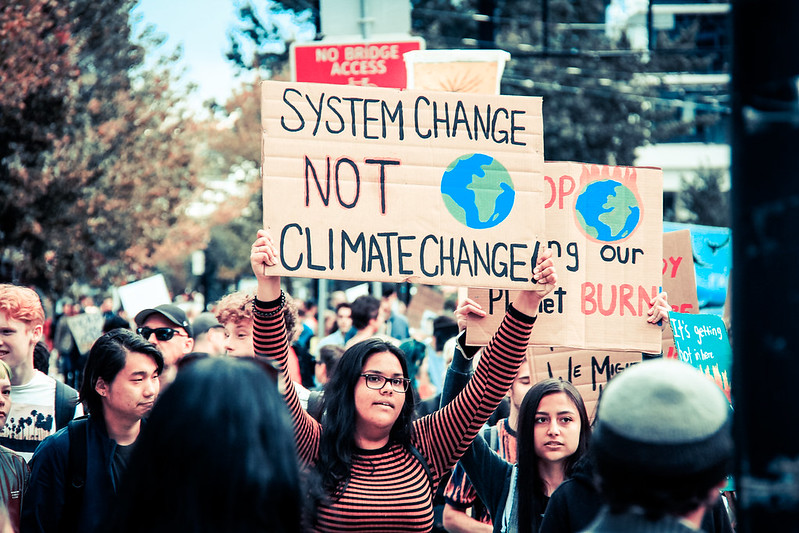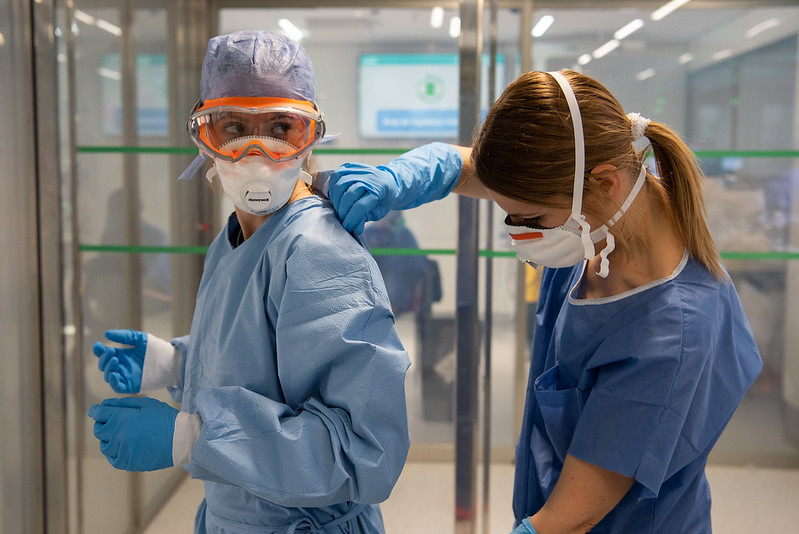As policymakers confront the crises of the pandemic, climate change and racial injustice, an investment in care infrastructure—and the work force and green jobs that power it—presents an urgent opportunity to address all three.

This article was originally published by The Century Foundation. It is reposted here with permission.
The COVID-19 pandemic has revealed the inadequacy of the systems that underlie nearly every aspect of U.S. society. The need for greater investment in the people and places that keep us healthy and connected has never been clearer. These systems—our schools, hospitals, child and elder care providers, community centers, and other parts of the “care economy”—are as much critical infrastructure as our roads and bridges.
As the Biden–Harris administration and Congress look to “build back better” and invest in our nation’s critical infrastructure, it must make a sustained, meaningful investment in care infrastructure: to support racial and gender equity, to build resilience, and to grow the economy as a whole.
It is well understood that investment in infrastructure projects has enormous job growth potential, and that infrastructure is foundational to a functioning economy. Although less traditionally viewed as infrastructure, care work is, likewise, the basis on which all other work can take place. As those who have trouble accessing it know, family care is necessary for all other work to be possible.
Investments in care infrastructure are more than just support for our families and students—they are also a critical component of building a sustainable economy. As we have previously written for The Century Foundation:
“A green job should refer to any position that is part of the sustainability work force: a job that contributes to preserving or enhancing the well-being, culture, and governance of both current and future generations, as well as regenerating the natural resources and ecosystems upon which they rely.”
Jobs in the education, health and child care sectors clearly fit those criteria.
As federal policymakers confront the parallel crises of the COVID-19 pandemic, climate change and racial injustice, a significant investment in our nation’s care infrastructure—and the work force and green jobs that power it—presents an urgent opportunity to address all three.

Health Care
As the U.S. struggles to keep the pandemic at bay, serve patients’ basic needs, and vaccinate the public, investments to our health system are clearly needed. This reckoning offers an opportunity to make the necessary changes that will create a more equitable and sustainable health system.
Currently, the health care sector accounts for nearly one-tenth of U.S. carbon emissions, and would rank seventh internationally as the biggest emitter if it was its own country. Chronic underfunding of the United States’ public health system has left the country underprepared for the current pandemic and increasing health challenges.
The U.S. health system is also inefficient and underperforming by international standards, paying twice as much on health care as comparable countries and getting poorer results. Our country ranks last in health care access and quality, and has higher hospital admissions for common chronic conditions, many of which are risk factors for COVID-19. As climate-induced disasters become more frequent and destructive, they will also become more costly in terms of lives lost, disability-adjusted life years, lost productivity, and health expenditures—and will put at highest risk our most vulnerable members of society.
There is wide potential for improving the health of the nation while also strengthening the economy and the sector’s work force. Climate change interventions offer shared benefits of health and environmental sustainability; reducing the incidence of climate-related disease and injury also reduces health care utilization and costs to consumers and the health system. Health care is also a huge and expanding sector of the economy, accounting for 17.7 percent of the nation’s GDP and approximately 23.4 million jobs.
While hospitals have played a pivotal role during the pandemic and are necessary pillars of our health system, they are also one of the biggest contributors to carbon emissions. Several major health systems have made efforts to use more renewable energy sources as part of their long-term goals for carbon neutrality. Others have taken steps to reduce energy use and waste, through changes in daily operations, energy retrofits, and weatherization projects. These interventions save money in the long run and add to the work force for green jobs.
In addition to access to health care, it is important to reduce vulnerability to climate-related health risks and address the social determinants of health in order to reduce preventable hospital admissions and reduce the strain on hospitals and their energy systems. Thus the attention to strengthening our medical care system must also include greater investments in local public health infrastructure and promoting primary and secondary prevention.
Greater funding to train and hire community health workers (CHWs) is one way to close the gaps in our health and social systems, and for vulnerable populations to gain advocates for their health. CHWs are important liaisons between community members and health resources, providing culturally-competent and patient-centered care, and identifying and managing common chronic physical and mental health conditions—before they result in a hospital admission. Many programs have successfully used CHWs to identify and control hypertension and other common chronic conditions, especially among high-risk patients. Adopting similar models and hiring and training trusted laypeople within the community, CHW programs offer thousands of good-paying jobs while improving the health of people with unmet social needs and challenges in accessing traditional health services due to transportation, distrust, language, and cost barriers.

Combined with greater exposure to environmental hazards and disproportionate rates of uninsurance and underinsurance, systemic inequities lead low-income communities of color to be more vulnerable to the impacts of climate change. Creating an equitable health system requires reducing vulnerability to these harms through improvements to health coverage and care access, as well as the social determinants of health. This includes vital investments in social infrastructure to improve education, wages, access to healthy and affordable foods, housing, environmental exposures, and other socioeconomic factors underlying health status.
The American Rescue Plan makes some steps towards strengthening our public health system. The relief package invests $7.66 billion in the public health work force and $7.6 billion for community health centers. While these provisions are intended to help stop the spread of the virus, the package also makes efforts to improve overall access to care and address health care disparities. It expands Affordable Care Act Marketplace subsidies, reducing the cost of health coverage and the number of uninsured Americans.
Another promising start is the Biden administration’s commitment to account for the “social costs” of greenhouse gas emissions in agencies’ regulatory actions; estimating the monetized damages of pollution will be essential for promoting decisions that produce social benefits from reducing environmental harm.
Child Care
We have seen the critical infrastructure role that child care plays in our economy during the past year: As child care providers have closed due to the pandemic—a projected 4.5 million slots permanently—our work force has directly suffered. Due in large part to lack of child care, over 2.3 million women left the work force between March 2020 and January 2021, a labor force participation rate equivalent to that of 1988. Additionally, a lack of access to safe and affordable child care could cost women, families and the economy $64.5 billion per year in the absence of a robust recovery, as a recent report from The Century Foundation and Center for American Progress found.
Even before the pandemic struck, access to affordable, quality care, whether for children, older adults, sick or disabled, has not been afforded equally to all Americans. Families of color, especially low- and middle-income households, have less access to adequate child care options, and more often live in child care deserts. These are the same populations that are more likely to have low-wage jobs with unstable schedules, in addition to having little or no access to sick or other paid time off—all of which make caring for children and family even more difficult. All of these issues have only been exacerbated by the pandemic, and without robust investments in this vital infrastructure, it will be much harder for individuals to pursue employment or training opportunities, and, therefore, for communities to bounce back from the recession.
The pandemic has turned the childcare problems into a crisis for mothers & caregivers. We know that, unlike many fathers who left the workforce early last year, most of the moms haven’t come back yet.
— Secretary Janet Yellen (@SecYellen) March 31, 2021
If they’re able to return it won’t be because we sat idly by — we must act.
Care work is essential low-carbon work and thus can be viewed as a vital sector of a green economy. If opportunities are made available, employment in the sector can constitute meaningful work for the millions of women who are currently out of work, even for those with few educational or professional qualifications.
Despite being essential work, due to a history of racism and sexism, the child care and domestic work force—disproportionately comprised of women of color—has been vastly underpaid, with most workers making less than $12 per hour as of 2019. Furthermore, much care work is done in the informal sector, in which, historically, it has been impossible for workers to band together to collectively bargain for wages or improved working conditions.
Accessible and affordable care sector can also enable other low-carbon work to be possible. In a forthcoming report by the Feminist Green New Deal Coalition, Lenore Palladino and Rhiana Gunn-Wright explain why investments in the care economy are a necessary condition for a just recovery and clean energy transition. In order to ensure that new green, low-carbon jobs are accessible to all Americans, not only white men that largely comprise the current clean energy sector, care must be affordable and accessible to all. Further, they say, “as structural racism compounds the difficulty of accessing childcare for BIPOC mothers, denial of access to green jobs will be worse for BIPOC women, as well as women in rural areas, where childcare deserts are more common.”
The $50 billion included in COVID-19 relief packages are a great start toward stabilizing the child care industry and ensuring centers across the country can continue operations—but it must be seen as a start of the longer process of ensuring everyone’s care needs can be met, and that care workers are paid living wages, with benefits and rights to collectively bargain. Further investments and policy making will be critical to advancing racial and gender equity and justice, growing our economy, and enabling access to vital low-carbon work now and in the future.
Before I took office, I promised you that help was on the way. Today, I signed the American Rescue Plan into law, and can officially say: help is here. pic.twitter.com/uuEZAkGloz
— President Biden (@POTUS) March 11, 2021
Education
Schools provide a unique opportunity to address the overlapping climate, racial inequity and economic crises, as they are in nearly every community in the country, already serve as community hubs in many places, and are a key cog in reinforcing—or reversing—racial inequality in the United States.
Our school infrastructure has long needed greater investment. Though comprehensive national data on school facilities in the United States is lacking, a 2016 study found that an additional $46 billion investment was needed each year to build and maintain adequate school facilities—a number that will only grow as buildings age, technology changes, and climate change requires new resiliency measures. Furthermore, school infrastructure spending—like spending on K–12 education more broadly—is not distributed equally: Low-income and Black and brown communities are more likely to need greater investment in their school facilities.
An impressive body of research has drawn a clear link between school building quality and educational and health outcomes, primarily between poor building quality and worse health outcomes, which in turn reduce student attendance and academic performance. Conditions such as mold, pests, lead, asbestos and even lack of temperature control all have detrimental effects on student health. Communities of color, already facing lower investment on average in their schools, also face higher exposure to the types of pollutants that are likely to exacerbate these health conditions.
The COVID-19 pandemic has thrown into even starker relief the health damages of outdated school facilities, and created new needs for all types of buildings. Most prominently, the link between COVID-19 spread and poor ventilation has brought new focus to the dismal state of heating, ventilation, and air conditioning (HVAC) systems in America’s schools: A recent Government Accountability Office study found 41 percent of school districts need to update or replace HVAC systems in at least half their schools, representing 36,000 schools across the country. Just as with other effects of school building quality on student health and success, reducing exposure to air pollutants has been shown in a variety of studies to improve academic performance. One study, focused on schools in Los Angeles near a gas leak, found that students attending schools with air filters saw a 0.20 standard deviation increase in mathematics and English scores.
By these measures alone, adequate investment in America’s schools would help to close the racial “opportunity gap” and provide an economic boost to both local communities and the national economy for decades to come. But schools, and school construction, provide benefits far beyond the education of the students who attend those schools. The Political Economy Research Institute (PERI) estimates that each million dollars of infrastructure spending on schools would create nearly 21 jobs—which, extrapolating the $46 billion annual investment in school facilities that has been estimated to be required elsewhere, would create nearly a million jobs each year.
An even greater investment—such as the $100 billion in the Reopen and Rebuild America’s Schools Act of 2021, and The Century Foundation’s 2021 policy priorities—would create an even greater number of jobs. Representative (and former principal) Jamaal Bowman has laid out one such ambitious vision, proposing a $1.16 trillion investment in the United States’s public schools to retrofit facilities and hire staff.
These jobs would not only provide an immediate boost to the national economy in the recovery from the COVID-19 recession, but could also provide high-paying jobs in construction and retrofit-related sectors to communities that have historically been shut out of these industries if paired with equitable hiring practices, such as the “hire local” commitments in many project labor agreements. Furthermore, teachers and other school staff positions are a critical part of a low-carbon economy, and building a more diverse teacher force would carry both educational benefits for all students and economic benefits for the communities of color that would see greater hiring for those positions.
Schools have also taken on an increasing role as climate- and disaster-response community centers, whether as shelter sites during storms and tornadoes, or as cooling centers during increasingly severe heat waves. No matter how effectively the United States and the international community respond to the climate crisis, our past inaction has ensured that disasters are going to worsen, at least in the short term, and the community center function of school facilities is going to be increasingly necessary. Retrofits and new construction will help communities weather these storms—both literally and figuratively—and will be especially necessary in frontline environmental justice communities that already are, and will continue to be, the most affected by the effects of climate change.
A New Way Forward
In all of these areas, policymakers must make affirmative choices to ensure that investments will advance racial and economic equity. Fortunately, there are a number of existing metrics that can help ensure these investments are targeted for equity. A wide-ranging equity screen, as has been proposed for more traditional brick-and-mortar infrastructure and climate investments, could be applied to investments in the education, care and health sectors as well.
More specifically, in child care, federal policymakers must invest in child care and early learning programs that prioritize the needs of marginalized communities and guarantee child care assistance to every family who needs it, especially across our nation’s child care deserts. Quality care should be defined to encompass a range of types of child care arrangements, like home care, and compensation should reflect the essential nature of this work.
For health care, greater investments in medically underserved areas (MUAs) and areas with large populations of medically-underserved people—such as Medicaid eligible, people of color, homeless, and migrant workers—can begin to address both environmental injustice and its associated health disparities.
In education policy, there are a wealth of demographic measures that could be used to drive investment in social infrastructure to the most urgently-needed areas, including student race and income data, and school-level data like Title I qualification.
The Biden–Harris administration has committed itself to racial and gender equity and investment in infrastructure to rebuild our economy and society from the COVID-19 crisis. To do so, federal policymakers must not be constrained by traditional conceptions of infrastructure and green jobs. Solving the climate crisis and further racial and gender equity will require valuing our care infrastructure as a critical part of a sustainable economy.
You may also like:





